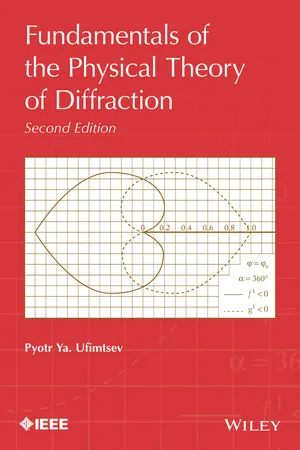
- English
- ePUB (mobile friendly)
- Available on iOS & Android
Fundamentals of the Physical Theory of Diffraction
About This Book
The book is a complete, comprehensive description of the modern Physical Theory of Diffraction (PTD) based upon the concept of elementary edge waves. The theory is demonstrated with examples of the diffraction of acoustic and electromagnetic waves at perfectly reflecting objects.
Readers develop the skills to apply PTD to solve various scattering problems. The derived analytic expressions clearly illustrate the physical structure of the scattered field. They additionally describe all of the reflected and diffracted rays and beams, as well as the fields in the vicinity of caustics and foci. Shadow radiation, a fundamental component of PTD, is introduced and proven to contain half the total scattered power. The equivalence relationships between acoustic and electromagnetic diffracted waves are established and emphasized. Throughout the book, the author enables readers to master both the theory and its practical applications.
- Plotted numeric results supplement the theory and facilitate the visualization of individual contributions of distinct parts of the scattering objects to the total diffracted field
- Detailed comments help readers understand and implement all the critical steps of the analytic and numeric calculations
- Problem sets in each chapter give readers an opportunity to analyse and investigate the diffraction phenomena
Frequently asked questions
Information
1
Basic Notions in Acoustic and Electromagnetic Diffraction Problems
1.1 Formulation of the Diffraction Problem






Table of contents
- Cover
- Titlepage
- Copyright
- Preface
- Foreword to the First Edition
- Preface to the First Edition
- Acknowledgments
- Introduction
- 1 Basic Notions in Acoustic and Electromagnetic Diffraction Problems
- 2 Wedge Diffraction: Exact Solution and Asymptotics
- 3 Wedge Diffraction: The Physical Optics Field
- 4 Wedge Diffraction: Radiation by Fringe Components of Surface Sources
- 5 First-Order Diffraction at Strips and Polygonal Cylinders
- 6 Axially Symmetric Scattering of Acoustic Waves at Bodies of Revolution
- 7 Elementary Acoustic and Electromagnetic Edge Waves
- 8 Ray and Caustic Asymptotics for Edge Diffracted Waves
- 9 Multiple Diffraction of Edge Waves: Grazing Incidence and Slope Diffraction
- 10 Diffraction Interaction of Neighboring Edges on a Ruled Surface
- 11 Focusing of Multiple Acoustic Edge Waves Diffracted at a Convex Body of Revolution with a Flat Base
- 12 Focusing of Multiple Edge Waves Diffracted at a Disk
- 13 Backscattering at a Finite-Length Cylinder
- 14 Bistatic Scattering at a Finite-Length Cylinder
- Conclusion
- References
- Appendix to Chapter 4: MATLAB Codes for Two-Dimensional Fringe Waves and Figures
- Appendix to Chapter 6: MATLAB Codes for Axial Backscattering at Bodies of Revolution
- Appendix to Section 7.7: MATLAB Codes for Diffraction Coefficients of Acoustic Elementary Fringe Waves
- Appendix to Section 7.8.3: MATLAB Codes for Diffraction Coefficients of Electromagnetic Elementary Fringe Waves
- Appendix to Section 7.9.2: Field dE(0)mod Radiated by Modified Uniform Currents J(0)mod Induced on Elementary Strips
- Index
- End User License Agreement